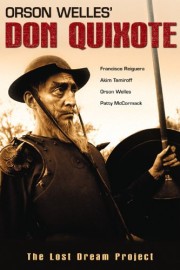Orson Welles’s Don Quixote
Orson Welles is known for the films of his that he didn’t complete as he is for the ones he did. One of the most famous of those incomplete films was his adaptation of Miguel de Cervantes’s legendary novel, Don Quixote. Welles isn’t the only person to have difficulty making a movie of the Man of La Mancha– see the indispensable documentary, “Lost in La Mancha,” to see Terry Gilliam’s tragic production –but he’s arguably the greatest filmmaker to embark on the task. In 1992, seven years after Welles’s death, filmmakers Jesus Franco and Patxi Irigoyen assembled the footage they were allowed access to, and put together a version that gave the world one more Welles film to pour over, and wonder what might have been had the filmmaker received the support from Hollywood he deserved.
The story is well-known: an old man has delusions of being a heroic knight, but the modern day always gets in the way of his heroism. He brands himself a knight errant named Don Quixote (Francisco Reiguera), and manages to convince a man to follow him as his squire, Sancho Panza (Akim Tamiroff). His fantasy world as the two ride through modern day Spain is one of giants and demons and damsels in distress, but motorcycles and cars and televisions keep foiling him as his dreams go unheralded.
Because the film is (obviously) an incomplete work instead of a restoration of a finished movie, it’s difficult to really critique the film for what it is than just to appreciate it as an experiment, not only by Franco and Irigoyen, but by Welles himself. This was a project Welles filmed off-and-on for decades, only to leave unfinished by the time he died in 1985. Did Welles ever intend to finish it? Was it just an opportunity for the great director to keep his filmmaking chops fresh for when he managed to work on films he DID get to finish, like “Touch of Evil” or “The Trial” or “Chimes at Midnight?” Or, would this film have been an example of Welles’s prankster cinema, like “F for Fake,” as is hinted at in the film’s second half, when the movie turns it’s premise on its head, and Welles adds a layer of symbolism to Quixote’s journey, not to mention predates the modern idea of “reality TV” by decades? We will never really know that answer to that, so it’s best to just sit back and enjoy watching an interpretation of footage made by one of cinema’s greatest storytellers, assembled in a way that shows the potential for what could have been, in context of accepting what is right in front of us, which is something both Welles and Quixote had difficulty doing at times.
As I said early, it’s difficult to review this in the typical critical manner. The footage is very rough, the dialogue sync is imperfect, and the cuts are sometimes jarring, which means the storytelling is incomplete. But what we get to see of the performances (especially those of Reiguera and Tamiroff) is enough to make us wish Welles had finished the film so that we could have one last, epic work from the director. For that reason alone, it’s a must-see for movie buffs, although everyone else will likely be bored. Taking all of these factors into account, a final grade of “B-” feels fair.










